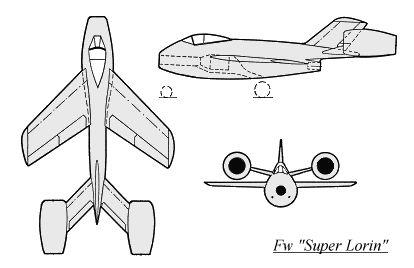| Type |
Single seat fighter |
| Engine |
1 Rocket engine and 2 Lorin Ramjets |
| Dimensions |
Length 11,6 m , height , span 7,6 m , wing area , |
| Weights |
Empty , loaded , max. take off weight |
| Performance |
Max.. speed , cruising speed , range , endurance , service ceiling , climb |
| Armament |
2 30 mm MK 108 |

"Super Lorin" was one of many "paper airplane" projects undertaken by German Aviation during World War II (1939-1945). The aircraft was designed by the engineers of the famous Focke-Wulf (maker of the famous Fw 190 fighter) and appeared in the final stages of the conflict as a possible solution for an interceptor. It utilized several advanced concepts of the time, including swept airfoils and ramjets for cruise flight. Ramjets were popular during the war for their promised speed, although their main limitation was the inability to propel an aircraft from a complete standstill - as such ramjets required a major form of auxiliary launch such as Rocket propulsion. The design of the Super Lorin is credited to aeronautical engineer Heinz von Halen. The Super Lorin uses a solid, round body with a bubble-like canopy above the nose. The nose also has an air intake into which the rocket motor can be sucked, an installation necessary to achieve the ramjet's minimum takeover speed of about 150 mph. The rocket is located in the belly of the machine and is ejected through an opening under the tail. The wing main aircraft is located forward amidships, with considerable sweep on both leading and trailing edges, while being centrally mounted on both sides of the fuselage. The empennage extends behind the main aircraft, with a vertical tail and two upward-sloping horizontal planes - each with a ramjet at the tip. The ramjet engine was a solution designed and developed by Lorraine himself. The close positioning of these engines on the aircraft fuselage is designed to limit airflow disturbances and create a more attractive, aerodynamically refined profile. The landing gear is all-wheeled, consisting of three legs (two main legs and one under the nose), in a tricycle arrangement that can be fully retracted into the aircraft fuselage. Equipped with a crew, suggested armament includes 2 x 30mm MK 108 series automatic cannons, which would allow the fast fighter to deliver a powerful punch against Allied bombers. These guns are mounted under the nose on either side of the missile air intake. The only recorded dimensions of the aircraft are a length of 11.6 meters and a wingspan of 7.6 meters. Like other Luftwaffe paper plane projects, the Super Lorin was not built in any physical form until the end of the German war in May 1945.


